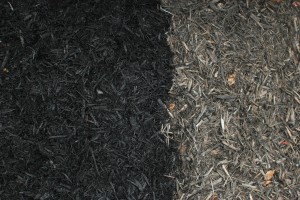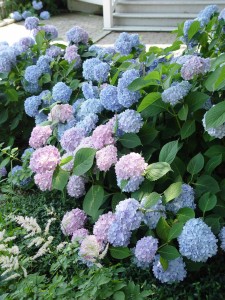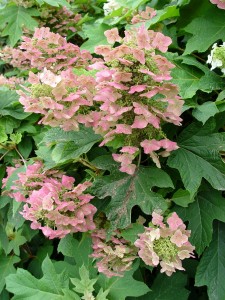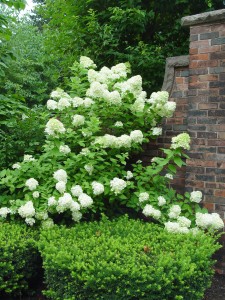Bleeding mulch, sacrificial cabbage and hydrangea-whacking
June 21st, 2011
Thinking about trying some of that dyed mulch?

A reader's black dyed mulch as delivered (left) and what it looked like after a rain 12 hours after application (right).
Don’t apply it right before a rain or you might find the color bleeds off and washes away.
That’s what happened to at least one local gardener after a recent rain. See the before and after shot at right.
“I had black mulch delivered and managed to spread it on our front beds,” the reader tells me. “That was the day we had quite a downpour at night. Well, lo and behold, the next morning my dark, black mulch was beige – the same color as natural mulch after it’s weathered for a year.
“I called my mulch provider, and he informed me that dyed mulch should not be spread if rain is expected within 24 hours because the dye has to ‘set’ by drying in the sun.”
This reader says he checked with a few other vendors and was told the same thing.
That raises two questions in my mind — why aren’t gardeners routinely told that at purchase time and why would a vendor even deliver dyed mulch when rain is forecast?
I’ve heard about dyed mulch bleeding onto people’s hands and onto driveways but never to that degree. To me, it’s just one more drawback to this kind of mulch.
Other questions about it include what’s in the dye (i.e. black mulch is often made from “carbon black,” which typically comes from burnt coal tar or oil), where the wood came from (demolition wood with lead-based paint? packing crates with leached chemicals?), and the possibility of the wood mulch growing nuisance fungi (especially the dreaded artillery fungus that shoots tarry dots all over the siding).
Click here to read a Pennlive Q&A I recently wrote about the pros and cons of dyed mulch.
Sacrificial cabbage
Another reader wrote to tell me about how gardeners in the Canary Islands (off the coast of Africa) use cabbage as a sacrificial crop around the outside of their gardens.
“Touring around, I kept seeing a plant around the perimeter of every garden,” Randi wrote. “On close inspection, I realized it was cabbage. I asked a local for the reason, and he looked at me kind of funny and said, ‘For the rabbits!’ Duh. Makes sense, no? Feed them to keep them out of the garden.”
This same strategy is what makes it possible for me to eke out a display of tulips – another rabbit favorite. I plant a few hundred bulbs so that even after the rabbits fill up on a hundred or so, there are still plenty left to bloom.
Whacking those hydrangeas
Few plants confuse people more than hydrangeas when it comes to pruning.
That’s partly because the pruning time varies depending on what kind of hydrangeas you’ve got.
The most common type is the big-leaf or Hydrangea macrophylla type, also known as “mophead” or “lacecap” hydrangeas. These usually bloom in balls of pink or blue, according to whether your soil is acidy or not (blue in acid soil, pink in neutral to alkaline soil).
This type of hydrangea blooms on last year’s wood, meaning that this season’s flower buds formed on buds that formed last summer and fall. If you whack these hydrangeas in fall, winter or spring, you’ll cut off all or most of the buds that would’ve opened into flowers.
The time to prune big-leaf hydrangeas is right after they’re done blooming, which is during the next few weeks.
Oakleaf hydrangeas also bloom on old wood and are best pruned in early summer after bloom.
Two other beautiful and fairly common kinds of hydrangeas bloom on new wood – i.e. branches that grow in spring, then form buds that open into flowers in summer.
These two are the native smooth hydrangeas (Hydrangea arborescens or the ‘Annabelle’ types) and the tree-type hydrangeas (Hydrangea paniculata or the ‘PeeGee’ types).
The time to prune these hydrangeas is end of winter, ideally right before new growth starts. Go ahead and cut them back hard if you want to keep the size compact.
Just to make it more confusing, some big-leaf hydrangeas (i.e. the ‘Endless Summer’ and ‘Forever and Ever’ lines) bloom on both old and new wood, which means you’ll get some flowers no matter when you prune.
Hydrangeas don’t have to be pruned, though, if the size is OK and they’re not getting so dense that leaf diseases are happening. If all’s well on those fronts, put the pruners away and enjoy the show.










